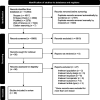Is Limited English Proficiency Associated With Differences in Care Processes and Treatment Outcomes in Patients Undergoing Orthopaedic Surgery? A Systematic Review
- PMID: 39031039
- PMCID: PMC11272327
- DOI: 10.1097/CORR.0000000000003034
Is Limited English Proficiency Associated With Differences in Care Processes and Treatment Outcomes in Patients Undergoing Orthopaedic Surgery? A Systematic Review
Abstract
Background: Approximately 25 million people in the United States have limited English proficiency. Current developments in orthopaedic surgery, such as the expansion of preoperative education classes or patient-reported outcome collection in response to bundled payment models, may exacerbate language-related barriers. Currently, there are mixed findings of the associations between limited English proficiency and care processes and outcomes, warranting a cross-study synthesis to identify patterns of associations.
Questions/purposes: In this systematic review, we asked: Is limited English proficiency associated with (1) differences in clinical care processes, (2) differences in care processes related to patient engagement, and (3) poorer treatment outcomes in patients undergoing orthopaedic surgery in English-speaking countries?
Methods: On June 9, 2023, a systematic search of four databases from inception through the search date (PubMed, Ovid Embase, Web of Science, and Scopus) was performed by a medical librarian. Potentially eligible articles were observational studies that examined the association between limited English proficiency and the prespecified categories of outcomes among pediatric and adult patients undergoing orthopaedic surgery or receiving care in an orthopaedic surgery setting. We identified 10,563 records, of which we screened 6966 titles and abstracts after removing duplicates. We reviewed 56 full-text articles and included 29 peer-reviewed studies (outcome categories: eight for clinical care processes, 10 for care processes related to patient engagement, and 15 for treatment outcomes), with a total of 362,746 patients or encounters. We extracted data elements including study characteristics, definition of language exposure, specific outcomes, and study results. The quality of each study was evaluated using adapted Newcastle-Ottawa scales for cohort or cross-sectional studies. Most studies had a low (48%) or moderate (45%) risk of bias, but two cross-sectional studies had a high risk of bias. To answer our questions, we synthesized associations and no-difference findings, further stratified by adjusted versus unadjusted estimates, for each category of outcomes. No meta-analysis was performed.
Results: There were mixed findings regarding whether limited English proficiency is associated with differences in clinical care processes, with the strongest adjusted associations between non-English versus English as the preferred language and delayed ACL reconstruction surgery and receipt of neuraxial versus general anesthesia for other non-Spanish versus English primary language in patients undergoing THA or TKA. Limited English proficiency was also associated with increased hospitalization costs for THA or TKA but not opioid prescribing in pediatric patients undergoing surgery for fractures. For care processes related to patient engagement, limited English proficiency was consistently associated with decreased patient portal use and decreased completion of patient-reported outcome measures per adjusted estimates. The exposure was also associated with decreased virtual visit completion for other non-Spanish versus English language and decreased postoperative opioid refill requests after TKA but not differences in attendance-related outcomes. For treatment outcomes, limited English proficiency was consistently associated with increased hospital length of stay and nonhome discharge per adjusted estimates, but not hospital returns. There were mixed findings regarding associations with increased complications and worse postoperative patient-reported outcome measure scores.
Conclusion: Findings specifically suggest the need to remove language-based barriers for patients to engage in care, including for patient portal use and patient-reported outcome measure completion, and to identify mechanisms and solutions for increased postoperative healthcare use. However, interpretations are limited by the heterogeneity of study parameters, including the language exposure. Future research should include more-precise and transparent definitions of limited English proficiency and contextual details on available language-based resources to support quantitative syntheses.
Level of evidence: Level III, therapeutic study.
Copyright © 2024 by the Association of Bone and Joint Surgeons.
Conflict of interest statement
Each author certifies that there are no funding or commercial associations (consultancies, stock ownership, equity interest, patent/licensing arrangements, etc.) that might directly pose a conflict of interest in connection with the submitted article related to the author or any immediate family members. All ICMJE Conflict of Interest Forms for authors and Clinical Orthopaedics and Related Research ® editors and board members are on file with the publication and can be viewed on request.
Figures
References
-
- Aggarwal A, Naylor JM, Adie S, Liu VK, Harris IA. Preoperative factors and patient-reported outcomes after total hip arthroplasty: multivariable prediction modeling. J Arthroplasty. 2022;37:714-720.e714. - PubMed
-
- Alvarez PM, McKeon JF, Spitzer AI, et al. Race, utilization, and outcomes in total hip and knee arthroplasty: a systematic review on health-care disparities. JBJS Rev. 2022;10:e21.00161. - PubMed
Publication types
MeSH terms
LinkOut - more resources
Full Text Sources
Research Materials


